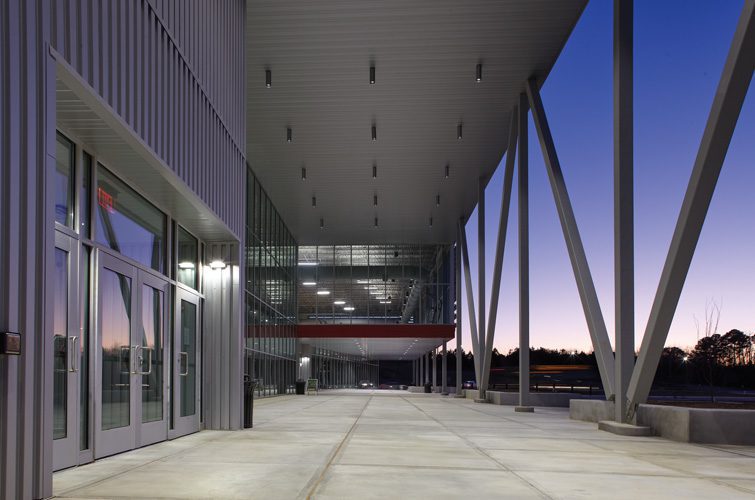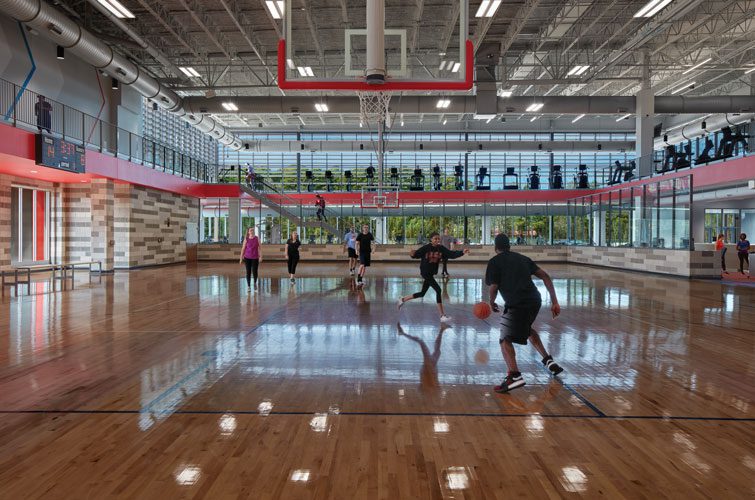The South Campus Recreation Center is a symbol of transformation at the University of Mississippi (Ole Miss), because before it was a rec center, it was a warehouse.
“We took a worn, dark appliance distribution warehouse and created a vibrant, bright recreation center,” said Peter Tulchinsky, the director of Campus Recreation. “I tell people to imagine walking into your local big box store like Home Depot or Walmart and take out all the merchandise. Keep the exterior walls, concrete slab, roof and columns, then make it a rec center.”
With a lot of natural light and 35-foot ceilings — which allows for the 35-foot and 360-degree Nicros climbing wall — the 98,000-square-foot facility offers 6,000 square feet of functional training and 25,000 square feet of fitness space that includes studios, basketball courts, etc. In fact, the university’s director of Facilities Planning calls the building the largest sustainability project on campus. Amanda Alpert, the associate director of programs, said it’s a bit unbelievable. “It’s just crazy how this space was transformed,” she shared.
All in all, Tulchinsky is proud they were able to utilize an existing structure in this way, even though it had its challenges and limitations. However, some elements of the warehouse have added to the facility’s new role as a rec center, like the windows adjacent to the basketball courts which were once doors to loading bays.
But ultimately, using a previous warehouse has created an open structure that allows you to view it all — standing outside the front of the building you can see all the way to the back wall, or from the mezzanine you can see from one corner to the next. “I think the lack of physical boundaries has also created an environment where there are fewer perceived barriers,” said Tulchinsky. “From the facility standpoint, the ‘open’ concept introduces people to activity and engagement they may not have previously experienced. The exposure to that experience creates a level of curiosity that may lead them to explore something new.”

The South Campus Recreation Center opened on August 26, 2019, and Campus Recreation partnered with HOK, JBHM and Zellner to make the old warehouse something new. But it wasn’t the only aspect of Ole Miss to transform. Professional development within the Campus Recreation department has evolved as well and is something the staff highlighted that makes them unique.
As the largest student employer on campus, there is a comprehensive student development curriculum in place. Alpert said it challenges students, both undergrad and graduate, to think critically about how their employment experience connects to academics, personal life and future career. “Career readiness is our priority,” she explained.
In fact, the department employs 14 graduate assistants (GAs), currently adding up to a one-to-one ratio of GAs to professional staff. Cheyanne Clouse is a second-year graduate assistant of fitness — and the 2019 NIRSA Student Leader. She said the opportunities to develop at Ole Miss have been endless. “The department is constantly looking to do more for us students,” said Clouse. “In terms of myself, one of my biggest points of growth would be my ability to handle some difficult situations. They’ve really helped me learn how to analyze situations with empathy, with accountability, with understanding.”
One of those development opportunities Clouse mentioned deals with committees. There are four in which professional staff, GAs and — if desired and nominated for — undergraduate students are involved. They are professional development, hiring, events and conferences, and emergency response. Staff are divided up based on their strengths, as well as what areas they want to gain more experience in. Plus, it’s an opportunity for individuals to get outside their usual teams and work with those they might not usually work with. Professional staff rotate through the committees.
In terms of specific development workshops for GAs, Alpert shared they dedicate a month at a time to one of their core values — Teamwork, Excellence, Adaptability, Mentoring, Communication and Respect, which lead to the acronym TEAMCR.
During one of the more recent workshops, Clouse said they took half a day to learn about what employers look for on resumes and cover letters. They did mock interviews, and they brought in an expert to talk about benefits and what a total compensation package looks like. Clouse said she was well prepared for her last interview because of the workshop.
The ultimate goal of student development at Ole Miss is to prepare students for the real world. Tulchinsky explained helping them see how their work connects to what lies outside of Campus Recreation is essential. But it isn’t just the student they are trying to educate either. “We need senior administrators on our campus to understand student employment is a high-impact practice,” he said. “Collegiate recreation needs to have instruments to measure the professional competencies and life-skills student employees develop in our programs, and better demonstrate the role we’re playing in the co-curricular student experience.”
However, experience at Ole Miss doesn’t stop with employment. It expands far beyond and includes many elements, from the substance misuse prevention program RebelADE and the Decision Making Model — students select either the climbing wall, yoga or a classroom setting, which will be paired with information on responsible decisions concerning substance use — to Unified Sports.

Gabby Sokol, the assistant director of intramural sports and sport clubs, said the Unified Sports program started at Ole Miss in 2014. It began with the Unified Egg Bowl Rivalry series and soon expanded, eventually becoming a sport club on campus, known as Special Olympics College: Unified Sports Club (SO College.) Campus Recreation facilitates all Unified Sports programs in partnership with SO College.
“Ole Miss offers this program to promote inclusion within sports,” said Sokol. “It has been an incredibly beneficial program for the university students, Special Olympic athletes and our program’s student staff members working the games.”
Programs include Intramural flag football, basketball leagues, Rivalry events and Special Olympics State Tournaments. From working in Unified Sports, Sokol has learned a lot. “One key takeaway is everyone has a place on a team, no matter how big or small,” she said.
Clouse shared she initially got involved as a participant in Unified Sports to support those running the program. Her mindset was, “This is something you all love; I’ll play.”
However, it quickly developed into much more. Since then, she’s participated in both basketball and flag football. “It just became something really fun and a new opportunity to meet people. I’ve been an athlete my whole life and I used to be extremely competitive,” shared Clouse. “It humbled me that it wasn’t always about winning.”
Support for the program is growing. Sokol said the campus community comes out to events to cheer, has featured SO College athletes during Ole Miss Football games and more. “This program promotes inclusivity on campus and gives those with and without intellectual disability the opportunity to participate in sport alongside one another,” she said.
And that is the theme that resonates, it seems, throughout Campus Recreation at Ole Miss. It’s the idea of coming together to build a better campus. As it enters a new future with the South Campus Recreation Center leading the way, student and professional staff are coming alongside one another to live out the motto of the department: Be Better.
It’s just two words, but they are powerful nonetheless. “If we’re all working to ‘Be Better’ in various aspects of our lives each day, hopefully we are setting an example of betterment for others to follow,” said Tulchinsky.










